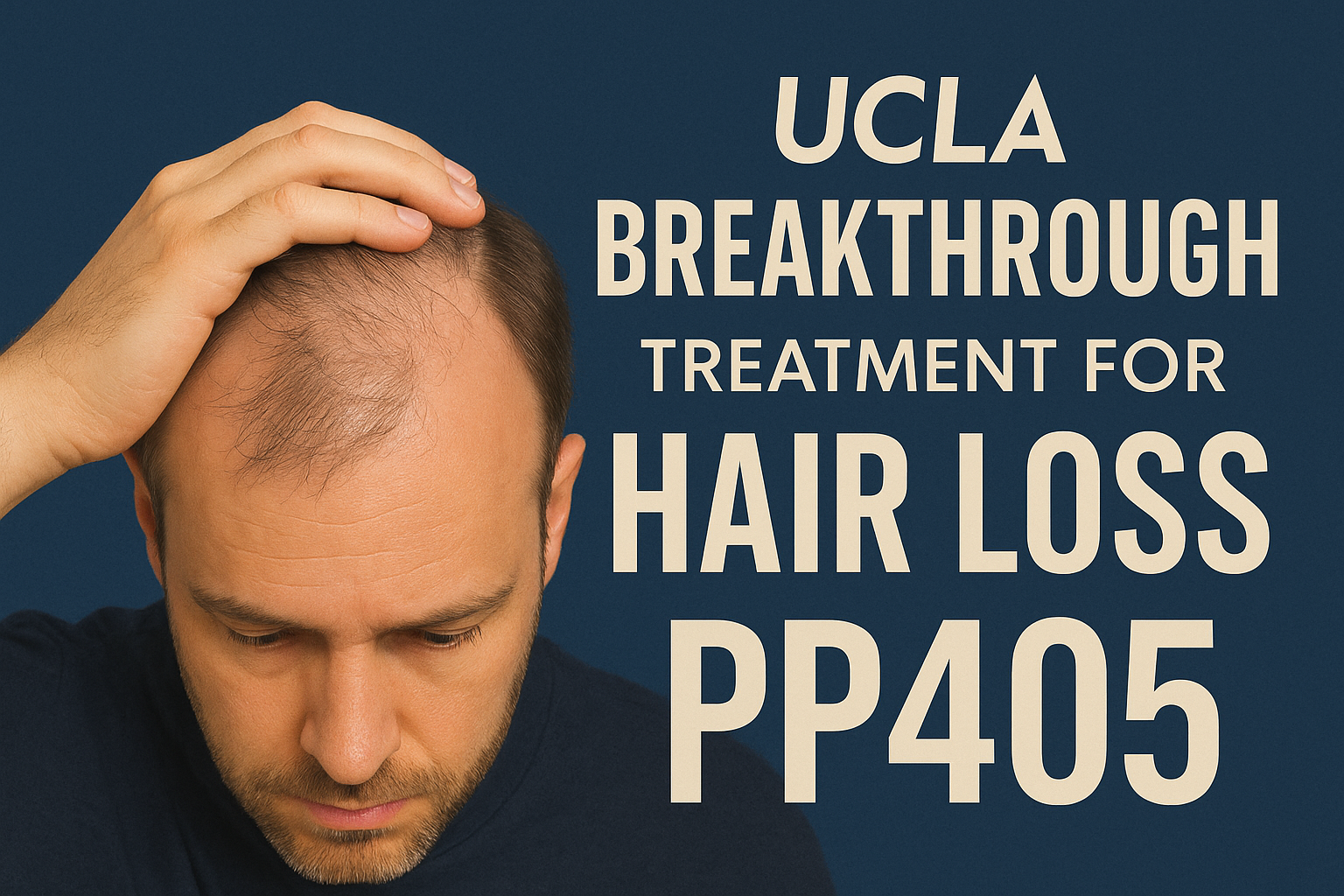UCLA’s Breakthrough PP405: A New Hope for Hair Loss

Losing hair can feel like losing a part of yourself. Whether it’s thinning patches, a receding hairline, or widespread hair loss, it’s a challenge millions face worldwide. But what if there was a new treatment that could help regrow hair and stop hair loss in its tracks? Enter PP405, a groundbreaking treatment from researchers at the University of California, Los Angeles (UCLA). This exciting discovery could change the game for people struggling with hair loss. Let’s dive into what PP405 is, how it works, and why it’s such a big deal—all in simple terms.
What Is PP405?
PP405 is a small molecule therapy discovered by UCLA researchers, licensed to Pelage Pharmaceuticals. It works in a totally unique way — by targeting the metabolism of dormant hair follicle stem cells on the scalp. Here’s how it works:
- Metabolic switch: PP405 inhibits the mitochondrial pyruvate carrier (MPC), altering energy production in follicle stem cells.
- This shift increases an enzyme called lactate dehydrogenase (LDH) and boosts a protein marker called Ki67 — both signs that stem cells are waking up cityskinclinic.com+15biospace.com+15artandscienceblog.com+15nypost.com.
- Basically, PP405 flips “off-duty” follicles back “on-duty” to reboot hair growth.
Unlike other treatments, PP405 targets the root cause — dormant stem cells — instead of relying on hormones or boosting blood flow.
Laboratory & Early Human Testing
- Lab & animal studies
In ex vivo human scalp samples and animal models, PP405 reactivated follicle stem cells within 24 hours. Researchers saw increased LDH and Ki67 signals — clear proof that the molecule does what it’s designed to ikclinics.co.uk+1reddit.com+1biospace.com. - Phase 1 human trial (2023)
- Topical PP405 (0.006–0.06%) was applied daily.
- It was found to be safe, well-tolerated, and stayed localized to the scalp — with no drug levels detected in blood samples artandscienceblog.com+1reddit.com+1reddit.com+15biospace.com+15artandscienceblog.com+15.
- Researchers also confirmed a rise in Ki67 signals within just 7 days, alongside early signs of new hair—hair “germs”—emerging parsamohebi.com+3biospace.com+3reddit.com+3.
These exciting results have paved the way for larger human trials.
Phase 2a Trial: Strong Early Signs
In early 2025, Pelage wrapped up Phase 2a studies involving both men and women with pattern baldness. Here’s a snapshot of key outcomes:
- Safety review: Participants used daily PP405 topical gel for four weeks, then followed for eight weeks. No adverse effects noted and no systemic drug absorption parsamohebi.com+12blstimes.com+12am870theanswer.com+12.
- Early efficacy: Among men with moderate to advanced hair loss, 31% saw >20% increase in hair density by week 8 — compared to zero positive response in the placebo group huffingtonpost.es+15blstimes.com+15am870theanswer.com+15.
- This result stood out because most other treatments take 6–12 months to show visible improvement, while PP405 induced growth within weeks reddit.com+15blstimes.com+15am870theanswer.com+15.
A key milestone: PP405 didn’t just enhance existing hair—it sparked new growth in previously bald patches, suggesting true regenerative effects medcitynews.com+14blstimes.com+14chemistry.ucla.edu+14.
What UCLA & Pelage Say
- Professor William Lowry (UCLA) emphasizes that PP405 wakes up dormant follicles and could produce full, terminal hair rather than fuzzy peach fuzz cityskinclinic.com+3newsroom.ucla.edu+3artandscienceblog.com+3.
- Though he cautions that “cure is a strong word,” the early human studies have been “very encouraging” reddit.com+1nypost.com+1.
- The UCLA Tech Transfer Group has spun out Pelage Pharmaceuticals to lead this work, raising over $16 million from investors like Google Ventures reddit.com+10chemistry.ucla.edu+10newsroom.ucla.edu+10.
Mindful Optimism & Community Voices
Reddit discussions reflect a mix of excitement and caution:
“PP405 isn’t a standalone cure…will work best combined with other treatments like finasteride.” reddit.com+15reddit.com+15ikclinics.co.uk+15
“It re‑activates dormant follicles—not un‑miniaturize vellus hairs.” huffingtonpost.es+7reddit.com+7artandscienceblog.com+7
So, while PP405 shows promise for reawakening live follicles, it’s not expected to regenerate dramatically shrunken hairs without additional support. And yes — its future likely includes combination treatments.
What’s Next?
- Phase 2b (ongoing, to complete by late 2025) will further check safety and early signals .
- Phase 3 studies may begin in 2026, depending on results, with market launch hopeful as early as 2027–2028 .
The timeline depends on outcomes, regulatory review, and further funding.
Final Thoughts
- PP405 represents a novel, non‑hormonal, stem‑cell–based approach to hair regrowth.
- Early trials show it’s safe, well-tolerated, and effective at reactivating dormant follicles.
- It may produce both density in existing hair and new hair growth in bald spots.
- While it won’t fix everything on its own, it opens the door to powerful combination therapies.
- Pending larger trials, PP405 might join the market around 2027–2028.
This is a big leap in hair-loss science — and unlike past “miracle cures,” it’s backed by rigorous clinical data. For readers dealing with thinning hair, PP405 offers hope grounded in real research.


